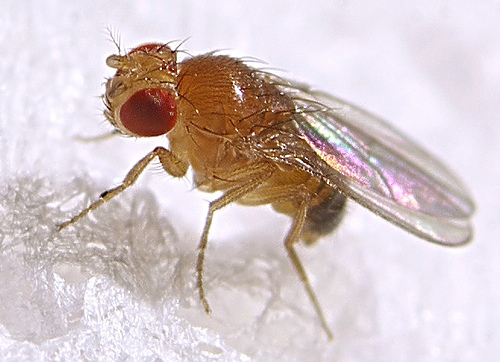
We’re always hearing about the amazing powers of some new aphrodisiac—oysters, figs, and even turnips have been said to increase the libido. However, there’s not a lot of science to back these claims up. For fruit flies, on the other hand, there is new evidence that food is extremely important in reproduction. In fact, according to a new study in Nature, the processes of food-sensing and courtship in these insects are intricately linked.
The fruit fly Drosophila melanogaster has long been used in laboratory research because it is easy to manipulate, and these tiny insects serve as a model system for many genetic and developmental studies. Years ago, researchers discovered that the fruitless gene (fru) controls much of the courtship behavior in Drosophila. Now, scientists have found that the same neurons that express fru also express a chemosensory receptor called Ir84a.
Since fru is expressed alongside this new receptor, the scientists suspected that Ir84a likely plays a role in courtship behavior. Indeed, they found that mutant males genetically programmed to silence Ir84a tend to court females far less frequently than normal males do. So far, so good: Ir84a seems to be important to reproduction.
Moving on with their idea, the researchers assumed that the receptor might be sensitive to pheromones from female fruit flies. However, when exposed to chemicals produced by potential mates, there was no response in Ir84a-producing neurons. After testing 163 other odors, the researchers found three compounds that elicited excitatory responses: phenylacetaldehyde, phenylacetic acid, and phenylethylamine. All three of these compounds are chemicals produced in fruits and plants, especially during fermentation.
Instead of being sensitive to pheromones produced by females, it seems that courtship behavior in fruit flies might be elicited by odors emanating from fermenting food. Overripe bananas, for instance, are full of phenylacetaldehyde and phenylacetic acid.
The researchers tested this hypothesis by placing males and females in a chamber with gauze that was saturated either with phenylacetic acid or with a control substance. The flies in the phenylacetic acid chamber courted twice as often as those in the control condition did. Meanwhile, when the same experiment was run with mutant flies that don’t express Ir48a, there was no difference in behavior.
This set of experiments neatly shows that compounds from fermenting plants promote courtship behavior in fruit flies via an olfactory receptor. Fruit brings flies together, serving as both a food source and an oviposition site. Since the setting is just right for mating, it makes sense that the scent of food might act as a cue to initiate reproductive behavior.
While different forms of Ir84a have been identified in various Drosophila species, other insects do not seem to have this type of receptor. Fruit flies may be unique (or at least rare) in that their food-sensing circuitry and reproductive behavior are so tightly coupled.
Nature, 2011. DOI: 10.1038/nature10428 (About DOIs).
Listing image by Photograph by iml.jou.ufl.edu
reader comments
7